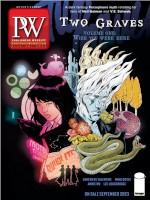Generous” is a word that artist Balint Zsako uses often in conversation, and it’s a good one to describe his debut, Bunny & Tree (Enchanted Lion), a wordless hand-painted picture book nearly 200 pages long that overflows with conceptual fireworks and deep emotion.
Bunny takes refuge under Tree’s branches with a hungry wolf in pursuit. Tree, a conscious being with a strong sense of compassion and arboreal superpowers, instantly rearranges its leaves and branches into the silhouette of an enormous wolf head, terrifying the attacker and driving it away. Relieved and grateful, Bunny then realizes that their eight bunny companions have also fled. Where have they gone? Bunny carefully digs Tree up and packs it into a red wagon, and the two set off in search for them, using Tree’s marvelous powers of transformation to cross oceans and scale mountains before they find what they are seeking.
Zsako was born in Budapest in 1979, the child of two artists. The family immigrated to Canada in 1988, and Zsako graduated with a BFA from Ryerson University in Toronto. He has focused on painting since then, with a steady stream of solo and group shows to his credit. The idea to tell a story in paintings grew out of nightly sessions with his young son Gus as he read him classic picture books. “Even the most sophisticated books depend on language,” he says. “Out of curiosity, I asked myself, ‘Can I be as sophisticated telling stories with pictures only?’ ”
The character of Tree came from paintings he had done for a show earlier that year, but Tree needed a companion. “A tree has leaves, texture—I wanted the other character to be a simple figure,” Zsako says. As an interlocutor, a rabbit was a fitting choice: “You can do a lot with ears.” The story’s animals recall traditional Eastern European folk art, with lean, lithe forms and expressionless faces.
A newcomer to picture book creation, Zsako did not plan the story out beforehand—no storyboard, no thumbnails. “I didn’t have a narrative structure at all,” he recalls, noting that he just let the images grow, one painting influencing the next. “It was an incredibly inefficient way to make a book,” he says. “I probably have half a book’s worth of paintings left over.”
Though he didn’t have an agent, he had some contacts in the publishing industry, and he made a list of people he thought might be interested in the manuscript. He encountered a string of nos. “Everybody was kind and open,” he says. “They genuinely gave it a chance, but I always appreciated their honesty that the book wasn’t right for them.”
Canadian artist Henrik Drescher, an old friend, knew Claudia Bedrick, publisher of Enchanted Lion, and gave Zsako her contact information. Bedrick had done unconventional books and was not daunted by the difficulties Zsako’s work presented. And Zsako resolved to pay attention to everything he was told. “I put my ego aside,” he says. “If they say we can make it better, I should do that.”
His work with the team at Enchanted Lion—Claudia Bedrick, Eugenia Mello, Emilie Robert Wong, and Emma Vitoria—had a profound effect on the book, “especially the narrative structure and some of the visual elements,” Zsako says. “Those aspects wouldn’t exist if it wasn’t for them.” The first half of the book survived, but the original ending (“It was much darker,” he says) was completely reworked.
Now Zsako is waiting to see how children respond to Bunny & Tree. “I’m super curious,” he says. “It’s such a puzzle. Kids have the capacity and even a hunger for the unusual and unexpected.”
As an artist, he’s gratified by another benefit offered by the picture book. “The gallery world is amazing and open, but there’s something intimidating about it. To make something that somebody can look at, at their own speed, in a place that’s safe to them—there’s something really appealing about that.”
Antonia Saxon is a book reviewer and features writer for PW.



 Volume 270
Issue 26
06/26/2023
Volume 270
Issue 26
06/26/2023





